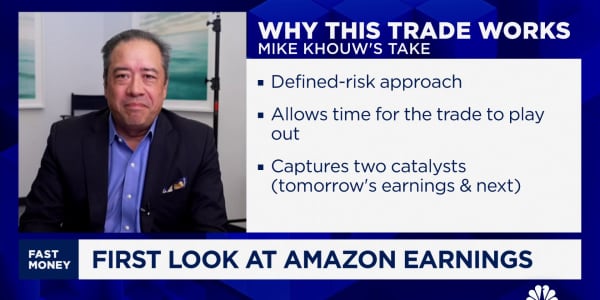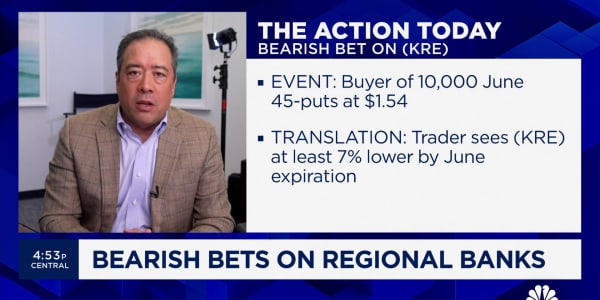Even if you're bullish on GoPro, you shouldn't buy shares of GoPro. Now, it's true that the stock is trading at almost four times its IPO price, but I'm not telling you to steer clear because of the incredible pace of the rally.
My point is much simpler: Because of some really wacky market dynamics when it comes to this stock, there is a far better way to bet that the run will continue.
With the stock near $95, you could buy the January 2015 95-strike calls, and sell the January 65-strike puts, for even money meaning that you don't need to spend anything at all to put this trade on.
Put another way, you could either buy the stock at $95, which means you will make money above $95 and lose it below, dollar for dollar. Or you could put on this options trade (which, by the way, is known as a "risk reversal") and make money above $95 and lose money below $65. Same upside, much less downside, you would skip the first 35 percent of losses!
Still not convinced that options are the way to play this thing?
How about this. You could purchase the stock at $95 today, or own the stock forward in January at $76. Not maybe, not sort of, but guaranteed.
Read MoreWe're positioned to meet demand: GoPro CEO
Just look at the options prices. You can buy a "synthetic long" position by buying a January 90-strike call for $10, and selling a January 90-strike put for $24. Add the call price to the strike price and subtract the put price, and you get the implied forward price of the stock. This position gives you the risk-reward profile of owning the stock for $76 in January.
If you are a long-term investor in GoPro, how, why, when would you consider purchasing it at $95 when you can own the exact same shares at a 20 percent discount?
Now, we'll get to the dynamics that make these sorts of no-brainer trades possible in a bit (hint: it's all about how difficult it is to short the stock). But first, let's take a deeper dive into the options market to find out how the real options pros trade.
Because for the serious options trading desks, buying the stock at a 20 to 35 percent discount isn't good enough. For them, only arbitrage profits will do.
Read MoreGoPro introduces new cameras
So how do GoPro options offer an opportunity for profits without any risk of loss? Admittedly it is not intuitive, and requires a more detailed understanding of the occasionally arcane concepts of options clearing. But I'm asking for some patience here, because this is important.
The Options Clearing Corp. (or OCC, as it is more commonly known) is a clearing organization which acts as the guarantor for all U.S.-listed options obligations. Centralized clearing is important in the secondary markets. It permits instruments to be traded without some kind of bilateral agreement (which is common in over-the-counter markets).
If two parties reach a bilateral contractual agreement, generally only the parties to the agreement can unwind said agreement. Trading would be difficult if we could only negotiate with the individual who transacted with us initially!
Essentially, when an options contract trades, one party holds the option to buy or sell the underlying instrument, while the other party is obligated by the options contract to sell or buy the underlying instrument if so instructed. However, the OCC actually stands in the middle.
If we exercise our option, the OCC is the guarantor of performance. If one is assigned, the OCC instructs the obligated party to perform the duty that was previously agreed to. In this capacity, the OCC is actually the counterparty to every listed options trade.
Why is this important? Because the OCC wants to be a fair and equitable organization. The OCC doesn't play favorites, and it doesn't single folks out. So if someone who owns options elects to exercise those options early, the OCC doesn't hunt down the party they traded with initially to assign them. Instead they assign pro rata. That means that all the member firms should be assigned proportionally.
When we transact in the marketplace, we rarely know who we're trading against. It is important that it doesn't matter. We would be more reluctant to transact if it did. Imagine adding a guess regarding who might be trading against you into your calculus.

Professional options traders understand that the pro rata rules actually provide an opportunity. If all market participants are not equally well-informed, some will not act as they should in every instance. That means I can get a piece of their (in)action. All I have to do is sit at the table. Across from me, the OCC will place my fair share of those that act optimally, and those that don't.
Only options holders have the option to act, so the opportunity to profit comes from being short options that holders fail to recognize should be exercised. The problem is, being short options is no guarantee of profits. Here is where the arcane rules come into play.
Clearing member firms can be both long and short the same options to the OCC. That may seem ridiculous, but it is necessary. If some of Merrill's customers buy options to open, they are long versus the OCC, and if some of Merrill's customers sell to open, they must also have a short position versus the OCC. The OCC can't simply net out longs and shorts at each clearing member, because the long and short positions may be held by different accounts.
However, those who can be long and short the same options are sometimes granted arbitrage opportunities. To wit: If I know that an option should be exercised, and I also know that others don't realize that, then I should do a riskless trade and both buy and sell the option to open. I will exercise my longs, and hope that I don't get assigned on all my shorts. The opportunity afforded by exercising the option will be mine to keep (ironically enough) whenever I'm not assigned, which will happen when other individuals do not exercise their options.
Here's an example:
- ABC stock is trading at $100 and it pays a very nice $1 dividend every quarter.
- The stock goes ex-dividend tomorrow. Owners of the stock today will receive the dividend, while those who purchase the stock tomorrow will not. The stock will be expected to drop $1 in price, as that expectation of a $1 dividend is embedded in the price of the stock at this point.
- The 50-strike calls, which expire this Friday are trading for $50 (parity). At this point, these are a proxy for the shares. I can buy the stock for $100, or I can buy the right to purchase the stock at $50, which must be worth at least $50 ($100 price - $50 strike = $50).
- If I buy the stock today, tomorrow I own a $99 stock, and am entitled to a $1 dividend.
- Options holders are NOT entitled to the dividend. So today my option is worth $50 ($100 stock - $50 strike). Tomorrow, the option is worth $49 ($99 stock - $50 strike)
- If I buy 1,000 options, and exercise all of them, I get 100,000 shares of the $99 stock, plus the $100,000 in dividends. No arbitrage there. However, if I simultaneously sell 1,000 options but only half of the open interest is exercised, I will be assigned pro rata, or on only 500 options contracts. So I get called out of 50,000 shares prior to the ex-dividend date, and am short 500 calls. Here's the exact breakdown.
- Buy 1,000 $50 calls to open for $50
- Sell 1,000 $50 calls to open
- On the close, I exercise the 1,000 long calls I purchased, which gives me the 100,000 shares at $50 each
- Overnight, I am assigned on 500 of the short calls I sell, which forces me to sell 50,000 shares at $50 each
- The next day, I am short 500 calls. These did not get the dividend, and are therefore worth $1.00 less. I am also long 50,000 shares and due $50,000 in dividends (that part washes).
- Enjoy the $50,000 I gained overnight in (almost) risk-free profit
This is essentially what is going on in GoPro, but it isn't dividends the options traders are after. It is the capacity for lending the shares.
GoPro has become hard—nigh impossible—to borrow. Options traders are trying to arbitrage retail participants who bought calls before the stock went much higher, but don't realize they should exercise their calls. In this case, they shouldn't exercise the options to receive a dividend, but because lending the stock is incredibly valuable. (In fairness to the retail fellow, chances are good that they cannot access the stock loan rebates, but others can.) Right now the overnight rate is almost 100 percent!
That means that if they exercise this arbitrage opportunity, every day a trader goes unassigned in the October 45-strike calls, they collect about 25 cents. That might not seem like much, but it adds up. In one week you've made $1.75 on a $95 stock. In one month you've made $7.50 on a $95 stock, or 8 percent. Bernie Madoff begins to look like a piker.
Read MoreThree things that could derail GoPro
Now, as I said, most retail investors cannot access this pretty incredible opportunity directly. However, they can take advantage of what the difficulty of borrowing the shares does to the options prices. Since the options market must follow the dynamics in the stock (in order to prevent an even bigger arbitrage opportunity from presenting itself) put prices become elevated, because there is a serious premium for maneuvers for betting the stock will fall.
This is why, again, those who would buy the stock for the long term at $95 can instead purchase it for $76 (or less) with options.
Now I hope that you fully understand the bold-sounding statement I started off with: Even if you're bullish on GoPro, you shouldn't buy shares of GoPro.
(One final note—I myself am no GoPro bull—actually, I'm bearish. But if you're going to bet on the stock, do it wisely!)






